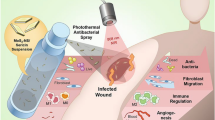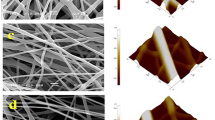Abstract
Nanofiber-based wound dressings have attracted much attention in wound care owing to their unique properties such as high aspect ratio and three-dimensional structure. Arginine is a precursor of nitric oxide that plays an important role in the wound-healing process. Therefore, in this study, we have developed a gel which contains lignin nanofibers (Lig-NFs) that were surface modified by arginine molecules via electrostatic interaction (Arg-Lig-NF gel). The effect of pH on the amount of arginine attached on Lig-NF surface was evaluated at three different pH values—5, 6, and 7. Fourier transform infrared spectroscopy and zeta potential of Lig-NFs before and after surface modification confirmed the surface modification of Lig-NFs with arginine molecules. The optimum gel composed of uniform Arg-Lig-NFs with diameter ranging from 100 to 250 nm. There was 184.60 ± 4.85 mg arginine in each gram of optimum gel. The release of arginine from Arg-Lig-NF gel showed a sustained release manner, and about 86.28 ± 3.50% of attached arginine were released after 24 h. Moreover, the optimum gel presented suitable viscosity and spreadability for topical application. The in vivo full thickness wound-healing assay carried out in rats demonstrated that the optimum Arg-Lig-NF gel can accelerate wound closure and increase re-epithelialization, collagen deposition, and angiogenesis significantly in Arg-Lig-NF gel-treated wounds compared to Lig-NF gel and arginine solution. Overall, these findings demonstrate that Arg-Lig-NF gel can be a promising material for the future development of effective hydrocolloid wound dressings used in the treatment of acute and chronic wounds.







Similar content being viewed by others
References
Lazarus GS, Cooper DM, Knighton DR, Margolis DJ, Pecoraro RE, Rodeheaver G, et al. Definitions and guidelines for assessment of wounds and evaluation of healing. Wound Repair and Regeneration. 1994;2:165–70.
Boateng JS, Matthews KH, Stevens HN, Eccleston GM. Wound healing dressings and drug delivery systems: a review. Journal of Pharmaceutical Sciences. 2008;97:2892–923.
Ovington LG. Advances in wound dressings. Clinics in Dermatology. 2007;25:33–8.
Choi JS, Leong KW, Yoo HS. In vivo wound healing of diabetic ulcers using electrospun nanofibers immobilized with human epidermal growth factor (EGF). Biomaterials. 2008;29:587–96.
Abdelgawad AM, Hudson SM, Rojas OJ. Antimicrobial wound dressing nanofiber mats from multicomponent (chitosan/silver-NPs/polyvinyl alcohol) systems. Carbohydrate Polymers. 2014;100:166–78.
Li H, Wang M, Williams GR, Wu J, Sun X, Lv Y, et al. Electrospun gelatin nanofibers loaded with vitamins A and E as antibacterial wound dressing materials. RSC Adv. 2016;6:50267–77.
Zahedi P, Rezaeian I, Ranaei-Siadat SO, Jafari SH, Supaphol P. A review on wound dressings with an emphasis on electrospun nanofibrous polymeric bandages. Polymers for Advanced Technologies. 2010;21:77–95.
Meftahi A, Nasrolahi D, Babaeipour V, Alibakhshi S, Shahbazi S. Investigation of nano bacterial cellulose coated by sesamum oil for wound dressing application. Procedia. Materials Science. 2015;11:212–6.
Cai N, Li C, Han C, Luo X, Shen L, Xue Y, et al. Mechanical and antibacterial properties of chitosan/gelatin nanofiber membranes with Fe3O4 nanoparticles for potential wound dressing application. Applied Surface Science. 2016;369:492–500.
Boudet AM, Kajita S, Grima-Pettenati J, Goffner D. Lignins and lignocellulosics: a better control of synthesis for new improved uses. Trends in Plant Science. 2003;8:576–81.
Chen H. Chemical composition and structure of natural lignocellulose. In Biotechnology of lignocellulose. Netherlands: Springer; 2014. p. 25–71.
Kai D, Ren W, Tian L, Chee PL, Liu Y, Ramakrishna S, et al. Engineering poly (lactide)-lignin nanofibers with antioxidant activity for biomedical application. ACS Sustainable Chemistry & Engineering. 2016;4:5268–76.
Kai D, Jiang S, Low ZW, Loh XJ. Engineering highly stretchable lignin-based electrospun nanofibers for potential biomedical applications. Journal of Materials Chemistry B. 2015;3:6194–204.
Barapatre A, Aadil KR, Tiwary BN, Jha H. In vitro antioxidant and antidiabetic activities of biomodified lignin from Acacia nilotica wood. International Journal of Biological Macromolecules. 2015;75:81–9.
Yousefi H, Faezipour M, Nishino T, Shakeri A, Ebrahimi G. All-cellulose composite and nanocomposite made from partially dissolved micro- and nanofibers of canola straw. Polymer Journal. 2011;43:559–64.
Dong D, Fricke AL, Moudgil BM, Johnson H. Electrokinetic study of kraft lignin. Tappi Journal. 1996;7:191–7.
Kolakovic R, Peltonen L, Laukkanen A, Hirvonen J, Laaksonen T. Nanofibrillar cellulose films for controlled drug delivery. European Journal of Pharmaceutics and Biopharmaceutics. 2012;82:308–15.
Pachuau L. Recent developments in novel drug delivery systems for wound healing. Expert Opinion on Drug Delivery. 2015;12:1895–909.
Luo JD, Chen AF. Nitric oxide: a newly discovered function on wound healing. Acta Pharmacologica Sinica. 2005;26:259–64.
Seifter E, Rettura G, Barbul A, Levenson SM. Arginine: an essential amino acid for injured rats. Surgery. 1978;84:224–30.
Kang Y, Kim J, Lee YM, Im S, Park H, Kim WJ. Nitric oxide-releasing polymer incorporated ointment for cutaneous wound healing. Journal of Controlled Release. 2015;220:624–30.
Blecher K, Martinez LR, Tuckman-Vernon C, Nacharaju P, Schairer D, Chouake J, et al. Nitric oxide-releasing nanoparticles accelerate wound healing in NOD-SCID mice. Nanomedicine: NBM. 2012;8:1364–71.
Liu P, Oksman K, Mathew AP. Surface adsorption and self-assembly of Cu (II) ions on TEMPO-oxidized cellulose nanofibers in aqueous media. Journal of Colloid and Interface Science. 2016;464:175–82.
Moritz S, Wiegand C, Wesarg F, Hessler N, Müller FA, Kralisch D, et al. Active wound dressings based on bacterial nanocellulose as drug delivery system for octenidine. International Journal of Pharmaceutics. 2014;471:45–55.
Khan AW, Kotta S, Ansari SH, Sharma RK, Kumar A, Ali J. Formulation development, optimization and evaluation of aloe vera gel for wound healing. Pharmacognosy Magazine. 2013;9:S6–S10.
Sinha UK, Gallagher LA. Effects of steel scalpel, ultrasonic scalpel, CO2 laser, and monopolar and bipolar electrosurgery on wound healing in guinea pig oral mucosa. Laryngoscope. 2003;113:228–36.
Li X, Fan R, Tong A, Yang M, Deng J, Zhou L, et al. In situ gel-forming AP-57 peptide delivery system for cutaneous wound healing. International Journal of Pharmaceutics. 2015;495:560–71.
Fan L, Zhou X, Wu P, Xie W, Zheng H, Tan W, et al. Preparation of carboxymethyl cellulose sulfates and its application as anticoagulant and wound dressing. International Journal of Biological Macromolecules. 2014;66:245–53.
Gal P, Toporcer T, Vidinský B, Mokrý M, Novotný M, Kilik M, et al. Early changes in the tensile strength and morphology of primary sutured skin wounds in rats. Folia Biologica. 2006;52:109–15.
Garcia-Orue I, Gainza G, Girbau C, Alonso R, Aguirre JJ, Pedraz JL, et al. LL37 loaded nanostructured lipid carriers (NLC): a new strategy for the topical treatment of chronic wounds. European Journal of Pharmaceutics and Biopharmaceutics. 2016;108:310–6.
Ahuja S. Handbook of bioseparations. New York: Academic Press; 2000. pp. 335.
Šurina I, Jablonský M, Ház A, Sladková A, Briškárová A, Kačík F, et al. Characterization of non-wood lignin precipitated with sulphuric acid of various concentrations. BioResources. 2015;10:1408–23.
Matsumoto Y, Kuroyanagi Y. Development of a wound dressing composed of hyaluronic acid sponge containing arginine and epidermal growth factor. Journal of Biomaterials Science. Polymer Edition. 2010;21:715–26.
Lin TY, Chen DH. One-step green synthesis of arginine-capped iron oxide/reduced graphene oxide nanocomposite and its use for acid dye removal. RSC Advances. 2014;4:29,357–64.
Kubo S, Kadla JF. Hydrogen bonding in lignin: a Fourier transform infrared model compound study. Biomacromolecules. 2005;6:2815–21.
Fried SD, Bagchi S, Boxer SG. Measuring electrostatic fields in both hydrogen-bonding and non-hydrogen-bonding environments using carbonyl vibrational probes. Journal of the American Chemical Society. 2013;135:11,181–92.
Ribeiro AJ, Silva C, Ferreira D, Veiga F. Chitosan-reinforced alginate microspheres obtained through the emulsification/internal gelation technique. European Journal of Pharmaceutical Sciences. 2005;25:31–40.
Yew HC, Misran M. Preparation and characterization of pH dependent κ-carrageenan-chitosan nanoparticle as potential slow release delivery carrier. Iranian Polymer Journal. 2016;25:1037–46.
Friedman AJ, Han G, Navati MS, Chacko M, Gunther L, Alfieri A, et al. Sustained release nitric oxide releasing nanoparticles: characterization of a novel delivery platform based on nitrite containing hydrogel/glass composites. Nitric Oxide. 2008;19:12–20.
Parirokh M, Sadeghi AS, Nakhaee N, Pardakhty A, Abbott PV, Yosefi MH. Effect of topical anesthesia on pain during infiltration injection and success of anesthesia for maxillary central incisors. Journal of Endodontia. 2012;38:1553–6.
Field CK, Kerstein MD. Overview of wound healing in a moist environment. American Journal of Surgery. 1994;167:S2–6.
Ajalloueian F, Tavanai H, Hilborn J, Donzel-Gargand O, Leifer K, Wickham A, Arpanaei A. Emulsion electrospinning as an approach to fabricate PLGA/chitosan nanofibers for biomedical applications. BioMed Res Int 2014;2014. https://doi.org/10.1155/2014/475280.
Druecke D, Lamme EN, Hermann S, Pieper J, May PS, Steinau HU, et al. Modulation of scar tissue formation using different dermal regeneration templates in the treatment of experimental full-thickness wounds. Wound Repair and Regeneration. 2004;12:518–27.
Dubský M, Kubinová Š, Širc J, Voska L, Zajíček R, Zajícová A, et al. Nanofibers prepared by needleless electrospinning technology as scaffolds for wound healing. Journal of Materials Science. Materials in Medicine. 2012;23:931–41.
Yu H, Peng J, Xu Y, Chang J, Li H. Bioglass activated skin tissue engineering constructs for wound healing. ACS Applied Materials & Interfaces. 2016;8:703–15.
Broughton G, Janis JE, Attinger CE. The basic science of wound healing. Plastic and Reconstructive Surgery. 2006;117:12S–34S.
Rieger KA, Birch NP, Schiffman JD. Designing electrospun nanofiber mats to promote wound healing—a review. Journal of Materials Chemistry B. 2013;1:4531–41.
Tonnesen MG, Feng X, Clark RA. Angiogenesis in wound healing. The Journal of Investigative Dermatology. Symposium Proceedings. 2000;5:40–6.
Balaji S, LeSaint M, Bhattacharya SS, Moles C, Dhamija Y, Kidd M, et al. Adenoviral-mediated gene transfer of insulin-like growth factor 1 enhances wound healing and induces angiogenesis. The Journal of Surgical Research. 2014;190:367–77.
Mammadov R, Mammadov B, Toksoz S, Aydin B, Yagci R, Tekinay AB, et al. Heparin mimetic peptide nanofibers promote angiogenesis. Biomacromolecules. 2011;12:3508–19.
Senturk B, Mercan S, Delibasi T, Guler MO, Tekinay AB. Angiogenic peptide nanofibers improve wound healing in STZ-induced diabetic rats. ACS Biomaterials Science & Engineering. 2016;2:1180–9.
Thakur VK, Thakur MK. Recent advances in green hydrogels from lignin: a review. International Journal of Biological Macromolecules. 2015;72:834–47.
Acknowledgements
The authors acknowledge Dr. Parvin Mahzouni (Professor of Pathology, Isfahan University of Medical Sciences) for the pathological and histological evaluations.
Author information
Authors and Affiliations
Corresponding author
Ethics declarations
The animal experiments were performed with the approval of the ethics committee of the Pharmaceutical Research Centre, School of Pharmacy, Isfahan University of Medical Sciences.
Conflict of interest
The authors declare that they have no conflict of interest.
Rights and permissions
About this article
Cite this article
Reesi, F., Minaiyan, M. & Taheri, A. A novel lignin-based nanofibrous dressing containing arginine for wound-healing applications. Drug Deliv. and Transl. Res. 8, 111–122 (2018). https://doi.org/10.1007/s13346-017-0441-0
Published:
Issue Date:
DOI: https://doi.org/10.1007/s13346-017-0441-0




